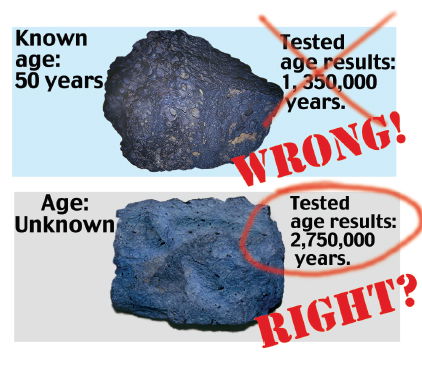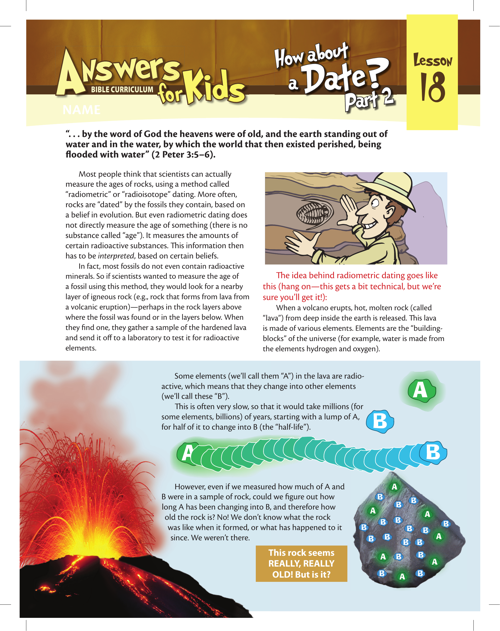Lesson 18: How About a Date? Part 2
by Stacia McKeever and Dan Lietha on March 28, 2016“. . . by the word of God the heavens were of old, and the earth standing out of water and in the water, by which the world that then existed perished, being flooded with water” (2 Peter 3:5–6).

Most people think that scientists can actually measure the ages of rocks, using a method called “radiometric” or “radioisotope” dating. More often, rocks are “dated” by the fossils they contain, based on a belief in evolution. But even radiometric dating does not directly measure the age of something (there is no substance called “age”). It measures the amounts of certain radioactive substances. This information then has to be interpreted, based on certain beliefs.
In fact, most fossils do not even contain radioactive minerals. So if scientists wanted to measure the age of a fossil using this method, they would look for a nearby layer of igneous rock (e.g., rock that forms from lava from a volcanic eruption)—perhaps in the rock layers above where the fossil was found or in the layers below. When they find one, they gather a sample of the hardened lava and send it off to a laboratory to test it for radioactive elements.
The idea behind radiometric dating goes like this (hang on—this gets a bit technical, but we’re sure you’ll get it!):
When a volcano erupts, hot, molten rock (called “lava”) from deep inside the earth is released. This lava is made of various elements. Elements are the “building-blocks” of the universe (for example, water is made from the elements hydrogen and oxygen).
Some elements (we’ll call them “A”) in the lava are radioactive, which means that they change into other elements (we’ll call these “B”).
This is often very slow, so that it would take millions (for some elements, billions) of years, starting with a lump of A, for half of it to change into B (the “half-life”).
However, even if we measured how much of A and B were in a sample of rock, could we figure out how long A has been changing into B, and therefore how old the rock is? No! We don’t know what the rock was like when it formed, or what has happened to it since. We weren’t there.

But Is It a Good Date?
The scientists who interpret these amounts of A and B to conclude that millions of years have passed must first assume three main things about the rock:
- How much A and B was in the rock when it hardened.
- A has decayed into B at the same rate over the years.
- The amount of A or B has not increased or decreased in any other way.
But because we haven’t been able to study all the rocks everywhere all the time, it’s impossible for us to know:
- If B was in the rock before it hardened.
- If A has always decayed at the same rate.
- If water, for instance, has removed some A or carried some B into the rock from elsewhere.
All of these factors will affect how “old” the rock appears—in practice, usually making it appear a lot older than it really is.

To test the radiometric dating method, some scientists gathered samples from hardened lava at Mount St. Helens, which erupted most recently in the early 1980s. The samples, which came from rocks that formed between 1980 and 1986, were sent to a lab and were “dated” using the potassium-argon (K-Ar) method. The test results ranged from between 340,000 to 2.8 million years old!
Other scientists collected samples from cooled lava flows from Mt. Ngauruhoe in New Zealand. These rocks are known to be less than 50 years old because people observed the volcano erupting in 1949, 1954, and 1975. But the lab results indicated that the rocks were up to 3.5 million years old!
The Bottom Line
If radiometric dating doesn’t work on rocks for which we know the ages, how can we trust it to work on rocks of unknown age?
After examining the assumptions behind this “dating method” and doing scientific experiments to see if this method works on rocks of an already known age, we find that “radiometric dating” isn’t all it’s cracked up to be. (Actually, any process used to find ages for things is based on assumptions, and so is not reliable.)
It’s important that we allow God’s written record of history, the Bible, to guide our thinking about the past—this includes our understanding of the age of the earth/universe and the age of fossils.
Want to learn more? Read the entire Answers for Kids Student Handout Set online!
 Download PDF
Download PDF
Answers for Kids Student Handout Set
These student handouts reinforce the lessons of the Answers for Kids Bible Curriculum while providing fun activities for children.
Browse Kids BookRecommended Resources
- © 2025 Answers in Genesis
- Privacy Policy
- Contact
- About



